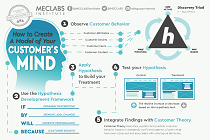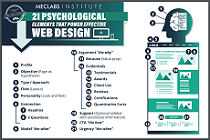
|
SUMMARY:
Brands spend a lot of money getting prospects to their websites, investing in everything from advertising to influencer marketing to SEO. But what if you get all these visitors and then…poof…they ghost you without making a purchase? All that traffic driving investment is for naught. Fear not, in this article we’ll show you how to fix websites where visitors browse but never buy. Read on for seven steps based on Meclabs vaunted Conversion Sequence Heuristic, along with real examples and insights from your peers. |
Action Box: This MeclabsAI Workflow will help you optimize your landing pages
Ready to improve your website’s conversion? Try this MeclabsAI Workflow now (from MeclabsAI, MarketingSherpa’s parent company).
Our first task is simple (but not easy): find where you’re losing potential customers.
Map the customer journey from first challenge to purchase and beyond. What questions and concerns do they have along the way?
Now, map out your marketing. How are you helping the customer make the best decision for themselves?
Your website plays a role in some of these steps. Once you understand the thought process, now pinpoint exactly where your ideal customers lose interest. Is it halfway through a landing page? Or deep into a cart?
Dive into your analytics and examine user behavior. Look at metrics like bounce rates, exit pages, time on site, and of course, conversion rate to the next step.
Don’t just rely on the numbers – observe how visitors interact with your site through heat maps and session recordings.
When you understand exactly where visitors are slipping away, you can make a hypothesis about the improvements that could better serve your customers at that step.
Here’s an example. A funeral home was getting plenty of relevant traffic – but barely any inquiries. After digging in, the team found that the drop-off in the customer journey was where the customer would expect to see pricing info. The pages just ended with a ‘contact us for details.’
“We added a clear pricing page with actual prices for bundled packages that included compassionate, plain-language explanations of what each option included. No sales pitch – just clarity,” explained Temmo Kinoshita, co-founder, Lindenwood Marketing.
The addition of clear pricing in the customer journey drove conversions across the entire range of packages, not just the lowest cost option.
Here's another quick example. "Decathlon is a really great sporting brand and a customer, and they recognized that it wasn't about the product listing pages, it wasn't their home pages," Dave Anderson, Vice President of Product Marketing, Contentsquare, told me in Customer Experience: Great experiences are invisible, but they require relentless alignment (podcast episode #145).
He continued, "it was the really confusing shipping calculator that they had on their checkout page. And they realized that's where everyone was dropping off. And so they went, 'we will focus there, and that's where we'll run our tests.' And they ran experiments on those. They saw an uplift."
The next few steps focus on the types of changes you can make at the conversion drop off point. Let’s start with value.
When someone lands on your page, they should immediately grasp what’s in it for them. This isn’t about listing features; it’s about connecting the benefits your product offers with your visitor’s needs and goals.
Now that you know where people are dropping off, analyze that page or cart step to see if you can improve the value proposition communication. And yes, this can even help in the cart. Once people get to your cart, there is mostly cost, cost, cost – give us your information, give us your money, create an account, etc. Remind them of the upside to keep them moving through the steps.
According to Meclabs methodology, your value prop messaging should have these four elements:
“We focus on language that connects with a real audience and highlights a clear value,” said Aaron Janes, founder, Ignite Web Design (a conversion-focused agency).
He gave an example of two service-based businesses that had the headline ‘Welcome to Our Company.’ They changed one headline to ‘Get Injury-Free Marathon Coaching for Runners Over 40’ and the other headline to ‘Stress-Free Property Management for Small Edmonton Landlords.’
Even a product can lost sales if you make it too long or difficult of a process to actually buy it.
Remove redundant form fields. Reduce the complexity of the checkout process. Simplify every step along the path to purchase.
For example, a pharmaceutical retailer’s product pages had solid traffic but conversions were very low. The team simplified the product variant selection, which had previously confused users with too many options.
Along with making changes to reduce anxiety (see next step), the team was able to increase conversion 42% and decrease the bounce rate 18% over the next six weeks.
“Addressing friction and building trust made all the difference,” said Dominic Bonaker, founder & CEO, LunarWP (the retailer’s agency).
When visitors feel secure, they are more inclined to convert. So another element that could hinder your site’s conversion is anxiety.
Some ways to reduce anxiety:
Here’s an example of social proof from world of high-trust purchases – in this case, engagement rings – where building credibility is especially key.
The team at Kimberfire created a dedicated ‘Kimberfire Couples’ section on the homepage. Instead of relying solely on traditional testimonials, they showcased real client photos capturing genuine moments of getting engaged to be married. These images not only humanized the brand but also provided potential customers with relatable proof that others have experienced joy with Kimberfire's products.
Creative Sample #1: Authentic user-generated content on diamond jewelry retailer’s homepage

“We linked the photos directly to the original posting of ours on Instagram, where the client tag is present. This allows the visitor to click through directly to verified social proof, rather than a photo hosted on our website,” explained Jonathan Goldberg, Founder & CEO, Kimberfire.
Reducing anxiety by showing potential buyers verifiable evidence of satisfied customers, along with other website improvements that were made around the same time, increased time on site and conversions (measured as appointment inquiries submitted),
Sometimes it’s even worth adding friction (discussed in step #3) to reduce anxiety. For example, Wrist Aficionado sells luxury timepieces and its website suffered from a low conversion rate.
Originally the site did what many ecommerce sites do – they had a simple ‘Buy Now’ button and removed the need for human interaction.
Upon analyzing the digital customer journey, the team realized this approach may be hurting conversion. “High-net-worth customers don’t make $50K+ purchases without human interaction,” said Phurba Sherpa, director of ecommerce, Wrist Aficionado.
The team introduced a custom inquiry system that allowed visitors to share their watch preferences, budget, and contact method. "Our sales team then followed up directly by email, phone or text, transforming a cold transactional experience into a relationship-driven process,” Sherpa explained.
The new customer journey led to a measurable increase in qualified leads and a significant lift in conversion rate.
Technical issues add another form of friction and anxiety.
To not belabor the obvious – your website needs to work well. If you make changes in the previous steps that hurt the fundamental operation of your website – or if it doesn’t work well to begin with – customers are less likely to buy. Why should they trust your product if they can’t even get your site to work properly?
For example, the design of your site could slow load time if images aren’t compressed and you don’t use a CDN (content delivery network). Or nav that works fine on desktop could get all wonky on mobile.
Even tactics that should increase your visitors’ likelihood to buy can hurt conversion if executed poorly.
Take personalization. This tactic can help you better tap into a customer’s motivation. However… “Most personalization systems are centralized, which introduces latency. That delay can hurt conversions more than the personalization helps,” says Aleks Haugom, GTM Senior Manager, Harper.
The above steps do not give you the exact answer for how to get website visitors to buy more on your website. They give you an idea – a hypothesis – for what could improve conversion.
To discover what really works, you need to make these changes and measure the results. Then use those test results to refine your approach gradually. Iterative testing is key to discovering what truly moves visitors to purchase because it helps us better understand real human (customer) behavior.
You could just make a change and then see what results occur, this is a form of testing. You could engage in user testing to observe actual visitor interactions.
But the gold standard is A/B testing, where you experiment with different layouts, headlines, CTA placements, images, etc by showing two (or more) different options to different customer sets and measuring how their behavior is affected.
For example, headline A might communicate value in a certain way while headline B communicates it in a different way. You split the traffic and show half of your visitors each headline. And then you measure the results to see what works best. You would also want to monitor for validity threats to ensure your tests provide accurate information.
Here's an example. A company in the OTT industry had the following hypothesis: removing the free trial would lead to an increase in the number of new paid customers per month.
The team created a fake door test so they didn’t need to build the product before they understood how likely customers were to purchase. They were looking for true intent and not just survey responses.
“Fake door testing is a research method whereby real users (at a scale that ensures statistical validity) are presented with fabricated products (fake doors) in the front end of a website or app. To the user, these appear to be fully fledged product offerings but in the backend no product actually exists,” explained Fraser Dunk, founder and CEO, Jurnii (the OTT company’s testing platform).
While the method involves presenting a product that doesn't actually exist upfront, it’s crucial to ensure that customers eventually receive a real, valuable offer and that they are not left feeling deceived. Ethical use of fake door testing requires debriefing users after the interaction. This helps maintain trust and shows respect for your customers.
In this case, after the transaction there was a message informing the user that the treatment products didn’t exist, and they were given the existing product – the free trial. Dunk notes that when fake door testing, the actual existing product “must always be a higher tier/cheaper offering.” In other words, you don’t want them to feel tricked, you want them to feel that they received something better.
The OTT company has a control (their original offering) and three treatments (variants that they hypothesized could improve conversion):
All three of the treatments decreased conversions:
However, since Treatment #1 was a direct signup of the product, it resulted in a 32% increase in paid conversions. So even though less people signed up for it than the free trial, since the free trial had drop-off before paid conversion, Treatment #1 was forecasted to produce millions of dollars more for the OTT company.
You can’t just test once and be done. Establish meaningful metrics – conversion rates, bounce rates, session lengths – and monitor them consistently.
These numbers help you keep a finger on the pulse of performance. Everything from macroeconomic changes (e.g., the global economy) to changes in your specific industry (e.g. you get a new competitor), to changes your company makes that are outside your control (e.g. it starts doing a poor job of fulfilling warranty requests and gets negative social media mentions) can affect a website that had previously been tuned to perfection.
For example, by monitoring the metrics, a team found that two weeks after changing a phone number on a website to a call button, calls dropped from 150 per week to 94 calls per week.
This led to further analysis where they discovered the button opened a phone’s calling app – which meant desktop users weren't able to make any calls.
“So we reversed the change and added a WhatsApp button for desktop users (for those using Whatsapp) and also an inquiry form,” explained Luca Tagliaferro, SEO director, Luca Tagliaferro Consultancy. Both these methods were hidden on mobile, where the phone call was still the preferred method of getting in touch.
AI Hackathon: Build a powerful lead gen agent in just 90 minutes – Join us July 30th at 2 pm EDT
Which of these has the biggest impact on conversion, but is most often ignored?
Above-the-Fold Psychology: How to optimize the top 4 inches of your webpage
7 Signs That You’re Overvaluing Search Engine Optimization
What Is Marketing Optimization: Examples of SEO, CRO, and website speed optimization
Get Better Business Results With a Skillfully Applied Customer-first Marketing Strategy

The customer-first approach of MarketingSherpa’s agency services can help you build the most effective strategy to serve customers and improve results, and then implement it across every customer touchpoint.
Get More Info >MECLABS AI

Get headlines, value prop, competitive analysis, and more.
Use the AI for FREE (for now) >Marketer Vs Machine

Marketer Vs Machine: We need to train the marketer to train the machine.
Watch Now >Live, Interactive Event

Join Flint McGlaughlin for Design Your Offer on May 22nd at 1 pm ET. You’ll learn proven strategies that drive real business results.
Get Your Scholarship >Free Marketing Course

Become a Marketer-Philosopher: Create and optimize high-converting webpages (with this free online marketing course)
See Course >Project and Ideas Pitch Template

A free template to help you win approval for your proposed projects and campaigns
Get the Template >Six Quick CTA checklists

These CTA checklists are specifically designed for your team — something practical to hold up against your CTAs to help the time-pressed marketer quickly consider the customer psychology of your “asks” and how you can improve them.
Get the Checklists >Infographic: How to Create a Model of Your Customer’s Mind

You need a repeatable methodology focused on building your organization’s customer wisdom throughout your campaigns and websites. This infographic can get you started.
Get the Infographic >Infographic: 21 Psychological Elements that Power Effective Web Design

To build an effective page from scratch, you need to begin with the psychology of your customer. This infographic can get you started.
Get the Infographic >Receive the latest case studies and data on email, lead gen, and social media along with MarketingSherpa updates and promotions.